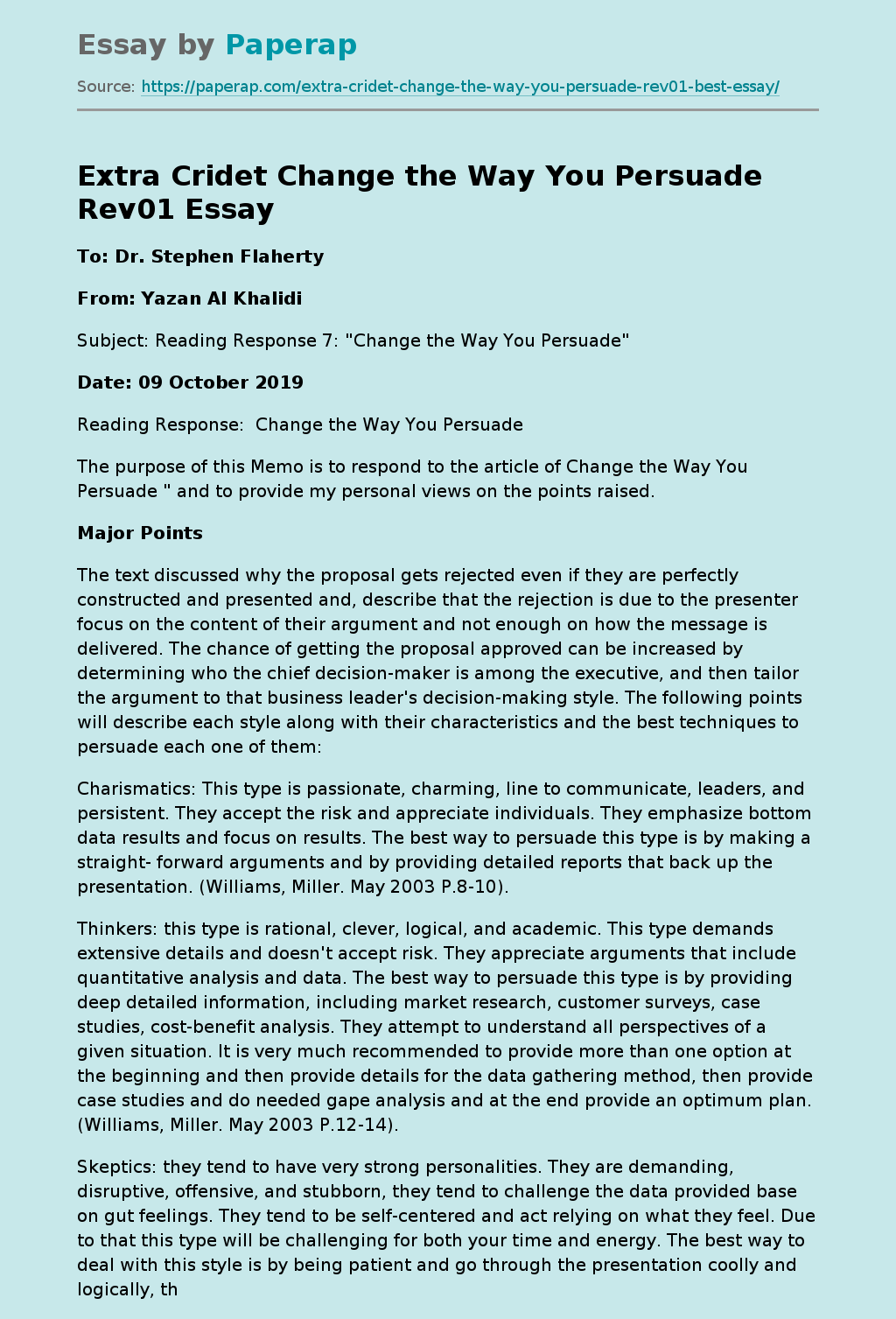Extra Cridet Change the Way You Persuade Rev01
To: Dr. Stephen Flaherty
From: Yazan Al Khalidi
Subject: Reading Response 7: “Change the Way You Persuade”
Date: 09 October 2019
Reading Response: Change the Way You Persuade
The purpose of this Memo is to respond to the article of Change the Way You Persuade ” and to provide my personal views on the points raised.
Major Points
The text discussed why the proposal gets rejected even if they are perfectly constructed and presented and, describe that the rejection is due to the presenter focus on the content of their argument and not enough on how the message is delivered.
The chance of getting the proposal approved can be increased by determining who the chief decision-maker is among the executive, and then tailor the argument to that business leader’s decision-making style. The following points will describe each style along with their characteristics and the best techniques to persuade each one of them:
Charismatics: This type is passionate, charming, line to communicate, leaders, and persistent.
They accept the risk and appreciate individuals. They emphasize bottom data results and focus on results. The best way to persuade this type is by making a straight- forward arguments and by providing detailed reports that back up the presentation. (Williams, Miller. May 2003 P.8-10).
Thinkers: this type is rational, clever, logical, and academic. This type demands extensive details and doesn’t accept risk. They appreciate arguments that include quantitative analysis and data. The best way to persuade this type is by providing deep detailed information, including market research, customer surveys, case studies, cost-benefit analysis.
They attempt to understand all perspectives of a given situation. It is very much recommended to provide more than one option at the beginning and then provide details for the data gathering method, then provide case studies and do needed gape analysis and at the end provide an optimum plan. (Williams, Miller. May 2003 P.12-14).
Skeptics: they tend to have very strong personalities. They are demanding, disruptive, offensive, and stubborn, they tend to challenge the data provided base on gut feelings. They tend to be self-centered and act relying on what they feel. Due to that this type will be challenging for both your time and energy. The best way to deal with this style is by being patient and go through the presentation coolly and logically, the most advantage of this style that they can tell the one what they think immediately. To increase success with this type it is crucial to building credibility with this style through someone they trust. Take into consideration that challenging this style is very risky and must be handled directly, accordingly if it is needed to correct a skeptic this should be done by giving him room to save face. (Williams, Miller. May 2003 P.15-17).
Followers: They tend to refuse risk, they see the world in other’s eyes. Followers can be spontaneous at times. They rely either on own or other past decisions to decide about the current situation or proposal. Followers are one of the most difficult to discover, but they are easy to be persuaded if the right technique is used. Firstly the follower should feel confident about taking a certain direction, and this can be done only by being very open with him and provide him with all the information and don’t hide any surprise. The proven methods and references and testimonials are big persuading factors for this style. (Williams, Miller. May 2003 P.18-20).
Controllers: This type relies on logical arguments, unemotional, practical, appreciate details, analytical, and unbiased. When it comes to personality their style is close to the skeptic as they have a strong one. They believe in their experience and knowledge and see that they are the best in each part of the business, accordingly they always judge ideas based on their experience and don’t count other perspectives. Dealing with this type should be by overcoming their internal fears, which they will pretend they dont have, and by chasing down some information at their request. The argument presented should be highly structured and should be tailored in a way that the make listener feels like he owns it. It is very much recommended to assist them with details which are provided by an expert. One of the worst things that can be done with a controller is to push the proposal too aggressively. This will lead to a direct rejection of the idea presented as they will assume that the presenter is part of the problem. Accordingly, the controller should be given time to take his decisions. (Williams, Miller. May 2003 P.21-23).
Agree/Disagree and Perceptions
The text is very much structured include many informative ideas, describe in detail each type of executive and, decision-maker, and give details of how to deal with each type, the text is information is given smoothly where the text describes how to discover the type of the decision-maker, then give main characteristics for the type and finally, suggest the way in dealing with the type described. In general, I do agree with all the points mentioned and I can’t find any sort of disagreement.
Conclusion
It is very important to know how to prepare the presentations and pitch ideas professionally, but the most important before making any step is to investigate the person we are trying to persuade and identify his style and, then tailor the presentation in a way that matches his style. This is the only key that can improve success. Executives have different types (Charismatics, Thinkers, Skeptics, Follower, and Controller) each type should be treated differently accordingly, the key to success is to follow the following structure:
References
(Conger, J.A. (2013, April 2). (HBR’s 10 Must Reads on Communication, P.1-23). (Change the Way You Persuade by Gary A. Williams Robert and B. Miller). Include the book publisher
The Power of Talk: Who Gets Heard and Why
Extra Cridet Change the Way You Persuade Rev01. (2019, Dec 15). Retrieved from https://paperap.com/extra-cridet-change-the-way-you-persuade-rev01-best-essay/

